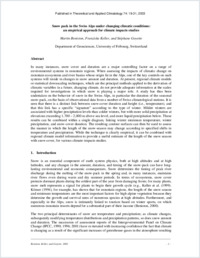Snow pack in the Swiss Alps under changing climatic conditions: an empirical approach for climate impacts studies
- Beniston, Martin Department of Geosciences, Geography, University of Fribourg, Switzerland
- Keller, Fransiska Department of Geosciences, Geography, University of Fribourg, Switzerland
- Goyette, Stéphane Department of Geosciences, Geography, University of Fribourg, Switzerland
-
2003
Published in:
- Theoretical and Applied Climatology. - 2003, vol. 74, no. 1-2, p. 19-31
English
In many instances, snow cover and duration are a major controlling factor on a range of environmental systems in mountain regions. When assessing the impacts of climatic change on mountain ecosystems and river basins whose origin lie in the Alps, one of the key controls on such systems will reside in changes in snow amount and duration. At present, regional climate models or statistical downscaling techniques, which are the principal methods applied to the derivation of climatic variables in a future, changing climate, do not provide adequate information at the scales required for investigations in which snow is playing a major role. A study has thus been undertaken on the behavior of snow in the Swiss Alps, in particular the duration of the seasonal snow-pack, on the basis of observational data from a number of Swiss climatological stations. It is seen that there is a distinct link between snow-cover duration and height (i.e., temperature), and that this link has a specific "signature" according to the type of winter. Milder winters are associated with higher precipitation levels than colder winters, but with more solid precipitation at elevations exceeding 1,700-2,000 m above sea-level, and more liquid precipitation below. These results can be combined within a single diagram, linking winter minimum temperature, winter precipitation, and snow-cover duration. The resulting contour surfaces can then be used to assess the manner in which the length of the snow-season may change according to specified shifts in temperature and precipitation. While the technique is clearly empirical, it can be combined with regional climate model information to provide a useful estimate of the length of the snow season with snow cover, for various climate-impacts studies.
- Faculty
- Faculté des sciences et de médecine
- Department
- Département de Géosciences
- Language
-
- English
- Classification
- Geography
- License
-
License undefined
- Identifiers
-
- RERO DOC 4903
- DOI 10.1007/s00704-002-0709-1
- Persistent URL
- https://folia.unifr.ch/unifr/documents/299711
Statistics
Document views: 139
File downloads:
- Texte intégral: 412
